HCG after eco. Dynamics of hCG levels after IVF.
Unfortunately, having difficulty trying to get pregnant naturally More and more women have to face this. And the only salvation for many of them is the procedure of in vitro fertilization, i.e. IVF, during which mature eggs are removed from a woman’s body, fertilized with male sperm, after which the embryo spends some time in a special incubator and then (usually after dividing up to 4, sometimes 8 cells) is implanted into the patient’s body.
After the embryo is transferred, a woman is most concerned about two questions: whether the embryo has taken root and whether the long-awaited pregnancy has occurred. The problem is that in the first few days after the embryo is transferred, a woman may experience signs of pregnancy even without the actual occurrence of one. And the only effective method to confirm or refute pregnancy is a concentration test human chorionic gonadotropin person. 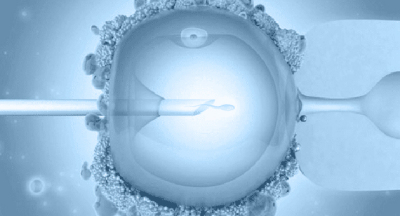
Basic information about hCG
Before you begin to study information about the dynamics of changes in hCG after IVF, you should familiarize yourself with the basic information directly regarding this substance. By its nature, hCG is a hormone produced by the membrane of the embryo, i.e. chorion cells. An increase in hCG concentration is observed in a woman immediately after fertilization. For example, home pregnancy tests respond to changes in the level of this hormone. ![]()
By regularly monitoring the hCG content, the doctor can monitor the course of pregnancy, promptly respond to possible deviations such as the threat of miscarriage, missed abortion, etc., and take the necessary actions to normalize the situation.
On average, laboratory changes in hCG concentration begin to be monitored 1.5-2 weeks after completion of the in vitro fertilization procedure. To do this, a woman can take a simple pregnancy test, having first purchased it at the pharmacy. Although the test is the simplest and most popular method of determining the presence of pregnancy, it can only be used to determine an increase in hCG levels, but not to track specific indicators of the concentration of this hormone in a woman’s body. 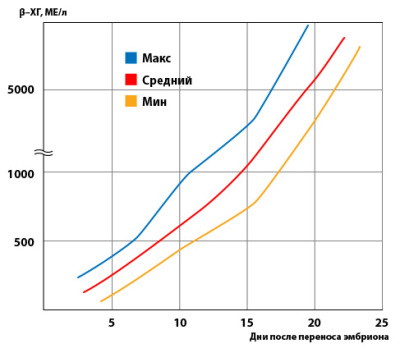
To determine the level of the hormone, a woman needs to donate either blood (more preferable) or urine (less accurate results). Typically, blood is donated for such an analysis during the first half of the period at the frequency recommended by the doctor, and if such a need arises, in the second half. The results of each measurement are recorded in the corresponding table, which will be discussed in detail below. 
Dynamics of changes in hCG concentration after in vitro fertilization
The concentration of hCG in non-pregnant women is on the order of 5-15 mU/ml. On average, the hormone level begins to increase 4-6 days after implantation of the embryo, sometimes later. At first, the growth dynamics of the hormone are slow, but already from 2-3 weeks of pregnancy, a more rapid change in the concentration of hCG is observed - the level of the hormone doubles every few days. Such dynamics are usually observed up to 3 months of pregnancy, after which the concentration of the hormone decreases. Then, starting from about 22 weeks until delivery, the hCG level increases again, but not as quickly as in the first stages.
To assess the condition of a pregnant woman as accurately as possible, doctors recommend taking hCG tests at 2-3-day intervals after IVF. Information regarding average normal hormone concentrations is given in the following table.
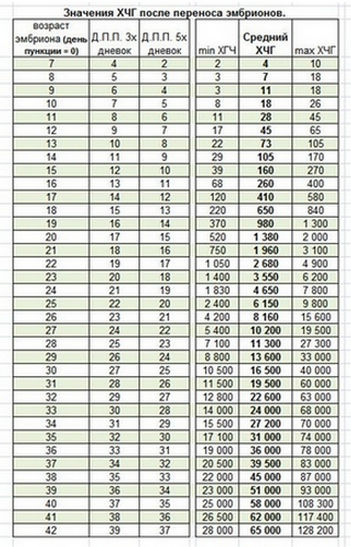
The table below is very easy to use. The 3-day DPP column indicates the hCG concentration values in the case of implantation of an embryo that was in the incubator for 3 days. The column called 5-day DPP reflects the same information, but for 5-day embryos.
So, if the patient was implanted with a three-day-old embryo, she needs to work with the second column. In the case of implantation of a 5-day embryo, the information from the 3rd column will be relevant.
Next, you find the day of the hCG test after embryo transfer and study the information given in the last three columns. The numbers opposite the day you selected are indicators of the normal concentration of hCG at the time of testing. 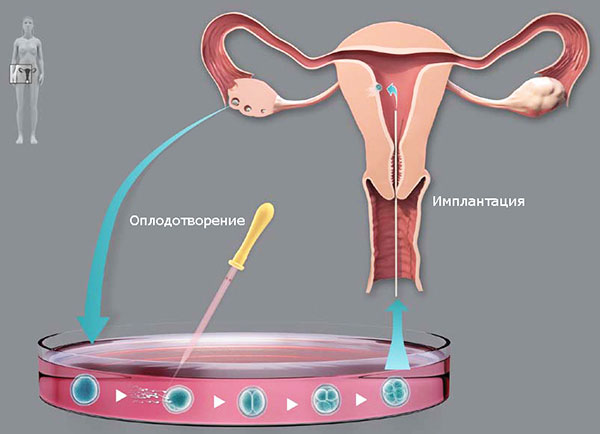
For greater objectivity, the table below includes indicators of the minimum, average, and maximum possible hCG levels. If your test results differ slightly from the figures given, there is no need to worry, at least if the doctor sees no reason to worry.
HCG for multiple pregnancies after IVF
As a rule, women undergoing IVF are implanted with several embryos at once - this increases the likelihood of successful fertilization. Often the situation develops in such a way that 2 (more is extremely rare) embryos take root at once, therefore, the woman becomes pregnant with twins. For such cases, hCG levels after IVF will be slightly different than for a singleton pregnancy. Information on this matter is given in the following table.
As noted, based on hCG levels, a specialist can draw conclusions about the existing risks of miscarriage and deviations in its course. Low levels of the hormone may indicate a missed pregnancy, placental insufficiency, or threatened miscarriage. Indicators above the established norm are often diagnosed in women with pronounced toxicosis, especially in early stages pregnancy, and in patients with diabetes.
Excessive concentrations of hCG during the second trimester of pregnancy often indicate various types of genetic abnormalities in the development of the child.
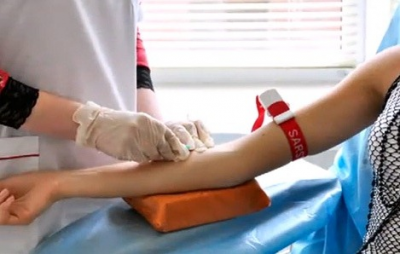 Thus, the hCG table after pregnancy allows us to draw conclusions about its course and the development of the fetus. That is why women need to take all prescribed tests in a timely manner so that, if necessary, a specialist can take timely action to solve detected problems. Along with this, the patient will also not have to donate blood for hCG throughout pregnancy. As a rule, in the first trimester, the hormone level is checked every 2-3 days, in the second much less often - on average once every 2-3 weeks. These points are individual and determined by the doctor during a personal examination.
Thus, the hCG table after pregnancy allows us to draw conclusions about its course and the development of the fetus. That is why women need to take all prescribed tests in a timely manner so that, if necessary, a specialist can take timely action to solve detected problems. Along with this, the patient will also not have to donate blood for hCG throughout pregnancy. As a rule, in the first trimester, the hormone level is checked every 2-3 days, in the second much less often - on average once every 2-3 weeks. These points are individual and determined by the doctor during a personal examination. 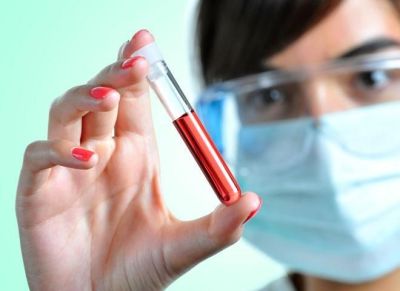
It is important to understand that although in vitro fertilization is one of the most highly effective methods of solving the problem of infertility, this procedure is still associated with higher risks compared to natural fertilization. Regular monitoring of hCG, in turn, is the most reliable method of monitoring the course of pregnancy. Therefore, every woman who decides to become a mother through IVF needs to follow the doctor’s prescriptions and carefully listen to his instructions, including in terms of regularly donating blood for hCG. 
Be healthy!
Video - HCG table after IVF

In vitro fertilization is an assisted reproductive technology used for female infertility. The extracted egg is fertilized in a test tube, the embryo is grown for several days in an incubator, after which it is transferred to the uterine cavity for further development.
A blood test for hCG helps to monitor the condition of the fetus; with the onset of pregnancy, the concentration of human chorionic gonadotropin should constantly increase until 7–12 weeks. Deviation from the norm indicates a threat of miscarriage, embryo death, or developmental pathologies in the unborn baby.
The dynamics of hCG after IVF allows you to monitor the increase in the level of the hormone in the blood. Human chorionic gonadotropin is produced by the placenta and ensures the normal course of pregnancy. Based on the results of the analysis, it can be determined whether the embryo transfer was successful.
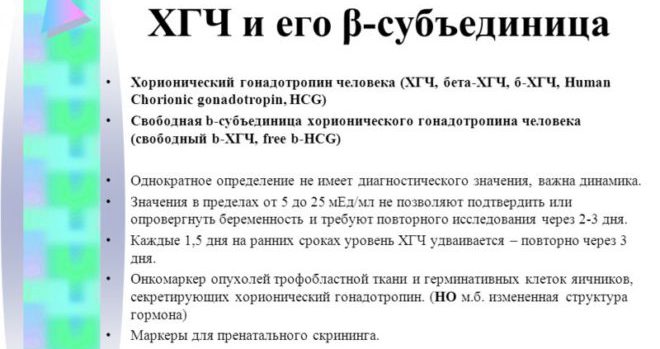
Comparative table of hCG by days after IVF:
| Day of puncture | DPO of 3-day embryos | DPO of 5-day embryos | Minimum hCG, honey/ml | Average hCG, honey/ml | Limit hCG, honey/ml |
| 7 | 4 | 2 | 2 | 5 | 10 |
| 8 | 5 | 3 | 3 | 6 | 17 |
| 9 | 6 | 4 | 3 | 10 | 18 |
| 10 | 7 | 5 | 7 | 18 | 25 |
| 11 | 8 | 6 | 11 | 28 | 45 |
| 12 | 9 | 7 | 16 | 45 | 64 |
| 13 | 10 | 8 | 23 | 72 | 104 |
| 14 | 11 | 9 | 29 | 107 | 172 |
| 15 | 12 | 10 | 38 | 160 | 271 |
| 16 | 13 | 11 | 67 | 260 | 402 |
| 17 | 14 | 12 | 123 | 411 | 585 |
| 18 | 15 | 13 | 210 | 655 | 850 |
| 19 | 16 | 14 | 375 | 970 | 1330 |
| 20 | 17 | 15 | 522 | 1382 | 2200 |
| 21 | 18 | 16 | 740 | 1965 | 3 050 |
| 22 | 19 | 17 | 1055 | 2650 | 4800 |
| 23 | 20 | 18 | 1420 | 3500 | 6220 |
| 24 | 21 | 19 | 1820 | 4653 | 7820 |
| 25 | 22 | 20 | 2500 | 6100 | 9850 |
| 26 | 23 | 21 | 4210 | 8150 | 15500 |
| 27 | 24 | 22 | 5500 | 10100 | 19510 |
| 28 | 25 | 23 | 7000 | 11320 | 27320 |
| 29 | 26 | 24 | 8830 | 13500 | 33 thousand |
| 30 | 27 | 25 | 10400 | 16400 | 40 thousand |
| 31 | 28 | 26 | 11550 | 19400 | 60 thousand |
| 32 | 29 | 27 | 12700 | 22500 | 63 thousand |
| 33 | 30 | 28 | 14 020 | 24100 | 68 120 |
| 34 | 31 | 29 | 15400 | 27100 | 70 thousand |
| 35 | 32 | 30 | 17 thousand | 30 thousand | 74 thousand |
| 36 | 33 | 31 | 19 thousand | 35 thousand | 77 thousand |
| 37 | 34 | 32 | 20400 | 39500 | 82 thousand |
| 38 | 35 | 33 | 22100 | 44 thousand | 86900 |
| 39 | 36 | 34 | 23 thousand | 50 thousand | 92 thousand |
| 40 | 37 | 35 | 24 thousand | 57 thousand | 108 thousand |
| 41 | 38 | 36 | 26400 | 61 thousand | 118 015 |
| 42 | 39 | 37 | 28120 | 65 110. | 130 thousand |
DPO – day after fertilization.
The hCG table for IVF allows you to determine the increase in the level of human chorionic gonadotropin. Maximum levels are recorded at 8–10 weeks, then begin to gradually decrease. On the 10th day after embryo transfer, it is possible to judge whether pregnancy has occurred; conception is confirmed if the hormone level is above 25 mU/ml. When results are below this value, fertilization has failed.
A woman should be tested on days 1, 3, 10 and 14 after the procedure. The data obtained is recorded, and an individual table for the growth of human chorionic gonadotropin is compiled, where the answers from laboratory tests are recorded.
Please note that data may vary between laboratories. The result is also influenced by weight, age, and the individual characteristics of the woman. Therefore, the analysis should be deciphered by a reproductologist.
Increase or decrease in hCG
Significant deviations from the hCG norm are an indication for visiting a doctor and undergoing an examination. A low level can be detected when:
- threat of miscarriage;
- freezing of the fetus;
- biochemical pregnancy;
- abnormalities of embryonic development;
- incorrectly determined time of conception;
- ectopic pregnancy;
- placental insufficiency;
- diabetes mellitus in the expectant mother.
If the hCG table after IVF indicates values twice and three times higher than normal, this may be a symptom of multiple births, which is often found with in vitro fertilization. In such cases, the first study will show 300–400 mU/ml 12–14 days after the embryos were transferred.
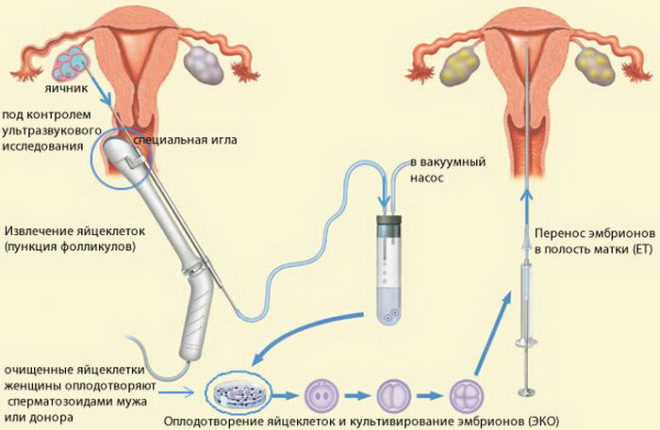
At multiple pregnancy the risk of spontaneous abortion increases significantly, so in most cases, excess embryos are removed from the uterus. About 1/3 of multiple fertilizations end in spontaneous reduction on the tenth to fourteenth day, that is, the body stops developing one or more embryos.
If the hCG level is significantly elevated in the 2nd trimester of pregnancy, there is a risk of fetal failure and the development of genetic pathologies (Down syndrome, Edwards syndrome). If the child is postterm, the concentration of human chorionic gonadotropin will also be higher than the maximum norm.
Blood is donated again after a few days to exclude erroneous results and assess the dynamics of hormone increases. Subsequently, the study is performed every 2 weeks, a hCG growth table is compiled, and the level of gonadotropin should increase by 1.5–2 times per day. When the hormone concentration is more than 1000 mU/ml, an ultrasound is prescribed (after 20–30 days of DPP), the study allows you to accurately establish or refute the presence of pregnancy and detect abnormalities in the development of the child.
For embryo transfer to be successful in the first days after in vitro fertilization, it is necessary to lead a sedentary lifestyle and avoid physical and emotional stress. If the expectant mother is too nervous, you can take soothing tea with chamomile or valerian; sedatives are contraindicated.

The expectant mother should protect herself from contracting colds and viral infections. To do this, you need to refrain from visiting public places, public transport, avoid contact with sick people, and avoid hypothermia.
You cannot take a hot bath, visit a bathhouse, sauna or solarium. This rule must be followed throughout pregnancy. It is not recommended to have sexual relations with your husband for 14 days. It is important to give up bad habits, lead a healthy lifestyle, and eat a balanced diet.
Medication support
To create favorable conditions for implantation of the fertilized egg, women are given an appointment hormonal drugs. Suppositories or tablets with progesterone and estradiol help prepare the endometrium of the uterus for the implantation of the embryo, prevent rejection of the embryo and contraction of the myometrium, and promote closure of the cervical canal. The most commonly prescribed suppositories are Utrozhestan, Duphaston, dermal gel Divigel, Crinon.

If the hCG table after embryo transfer shows a low level of human chorionic gonadotropin, a synthetic analogue of the hormone (Pregnil) may be prescribed. To regulate the immune relationship between mother and fetus, Dexamethasone and Cortisol are prescribed. Women after IVF are advised to take antihypoxic vitamins: C, E, β-carotene, folic acid.
Drug support is provided until the 14th day after IVF, when an hCG test confirms pregnancy. In some cases, therapy is carried out for a longer period, it all depends on individual indications. The duration of taking hormones is determined by a fertility specialist. This takes into account the patient’s age, the presence of gynecological diseases, experience of previous in vitro fertilization, and hormonal disorders.
Observing the dynamics of hCG growth day by day after embryo transfer allows us to assess the condition of the fetus, confirm or exclude pregnancy, and timely identify abnormalities of intrauterine development. A decrease in the level of human chorionic gonadotropin in the blood serum may indicate a threat of abortion, placental insufficiency or biochemical gestation. For successful IVF, a woman must regularly donate blood for hCG, take maintenance medications and be observed by a doctor.
There are no similar entries.
The main indicator of pregnancy is the level of hCG in a woman’s blood. Methods for determining the presence of the hormone include a pregnancy test and a blood test. It is necessary to consider in more detail the norms and rates of increase in hCG during IVF.
HCG (human chorionic gonadotropin) is a hormone that increases significantly during pregnancy. After fertilization of the egg and formation of the placenta, the number of hCG begins to quickly double. This factor is a positive sign of a successful pregnancy.
When carrying out an IVF procedure, the development and growth of hCG are the main components of the beginning of a pregnancy obtained artificially. The norm is a constant increase in the hormone until the 12th week of pregnancy. Having reached the maximum hCG value, it begins to decrease to a certain point.
Carrying out a blood test for hCG content
The onset of pregnancy after embryo transfer can be confirmed after two weeks. But at the same time, it is possible to conduct a special blood test to check the level of hCG, monitoring its dynamics and growth.
In order to determine successful fertilization during IVF, you should know the minimum and maximum values of hCG in units of measurement (mIU/ml).
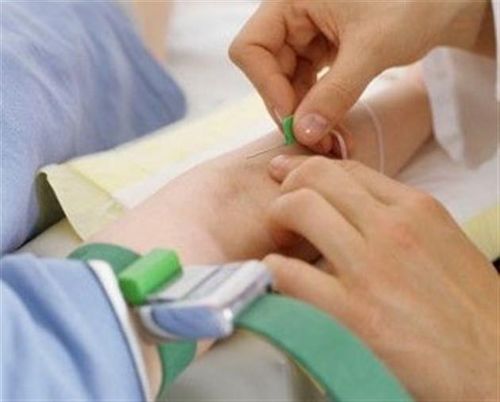
A positive hCG number is not a 100% guarantee of pregnancy, so monitoring with ultrasound will give an accurate answer. The specialist will monitor the development of the process and rule out ectopic pregnancy, and will also check the number of attached embryos.
Normative hCG table after IVF
A special blood test for hCG levels after embryo transfer must comply with established standards to determine the success of the process. Below is a table of hCG values at different periods and the dynamics of its growth.
| Number of days after transfer | Age of the embryo before transfer | HCG norm in units of measurement | |
| 3 days | 5 days | ||
| 7 | 4 | 2 | 3–12 |
| 8 | 5 | 3 | 4–22 |
| 9 | 6 | 4 | 6–26 |
| 10 | 7 | 5 | 10–28 |
| 11 | 8 | 6 | 12–50 |
| 12 | 9 | 7 | 21–70 |
| 13 | 10 | 8 | 24–110 |
| 14 | 11 | 9 | 32–180 |
| 15 | 12 | 10 | 42–300 |
| 16 | 13 | 11 | 75–420 |
| 17 | 14 | 12 | 130–510 |
| 18 | 15 | 13 | 225–900 |
| 19 | 16 | 14 | 420–1500 |
| 20 | 17 | 15 | 630–2100 |
| 21 | 18 | 16 | 830–3300 |
| 22 | 19 | 17 | 1200–5100 |
| 23 | 20 | 18 | 1500–6500 |
| 24 | 21 | 19 | 2150–8000 |
| 25 | 22 | 20 | 2600–10200 |
| 26 | 23 | 21 | 4700–16000 |
| 27 | 24 | 22 | 6000-20000 |
| 28 | 25 | 23 | 8700–28500 |
| 29 | 26 | 24 | 9400–35000 |
| 30 | 27 | 25 | 12200–42000 |
| 31 | 28 | 26 | 13000–62000 |
| 32 | 29 | 27 | 13900–70000 |
| 33 | 30 | 28 | 15200–72000 |
| 34 | 31 | 29 | 16000–78000 |
| 35 | 32 | 30 | 18600–84000 |
| 36 | 33 | 31 | 20050–90000 |
| 37 | 34 | 32 | 21300–96000 |
| 38 | 35 | 33 | 22900–101000 |
| 39 | 36 | 34 | 24900–110000 |
| 40 | 37 | 35 | 27000–120000 |
| 41 | 38 | 36 | 29000-124000 |
| 42 | 39 | 37 | 30000–129500 |
Rules for using the table
Determining the level of hCG in the blood is quite easy using some calculations.
- The exact date of the study. It is necessary to determine the age of the embryo (3 days or 5 days), then calculate the number of days after embryo transfer. Next, check the value against the table;
- To calculate the exact number of days after transfer, use the column with the desired embryo age. If this factor is not taken into account, the hCG values will be incorrect;
- The last column of the table indicates the approximate average value of the normative hCG content in a woman’s blood. Therefore, if there are any deviations, you should consult a doctor and not draw your own conclusions!
Therapy with hormones
Pregnancy following IVF is often accompanied by threatening symptoms. These include: low hCG levels, bloody discharge, nagging pain in the uterine area. If these signs are present, the leading gynecologist should prescribe complex therapy aimed at maintaining pregnancy.
The main methods of prolonging pregnancy after IVF: 
- Prescription of the hormone progesterone. Progesterone is a pregnancy hormone responsible for its successful course. During IVF, the hCG level may not be high enough, so taking medications containing the hormone progesterone is recommended. The most popular drugs are duphaston and utrozhestan. But only the attending physician should prescribe the exact dosage and period of taking the medicine!
- Complex vitamin maintenance therapy. To maintain pregnancy, doctors also prescribe vitamin E, folic acid, hemostatic drugs as needed, magnesium droppers, food rich in valuable microelements and substances.
- Maintaining a moderate rhythm of life. After embryo transfer and pregnancy, a woman is recommended to have a quiet life schedule. Extreme sports, intense physical activity, and nervous disorders should be excluded. It is necessary to limit your stay in public places to avoid infectious diseases such as colds or flu. The immune system is very weakened, as the body begins to work for two.
Signs after IVF with an increase in hCG
It should be noted that there are no special signs of an increase in hCG. If a woman feels any changes in her body, they are not always an accurate confirmation of the onset of pregnancy.
A test for hCG levels during IVF can be done no earlier than two weeks after the procedure. The gradual growth of the hormone is monitored by constant testing of hCG levels in the blood, but this must be done almost every day. If there is a threat of pregnancy failure during IVF, doctors prescribe this test in order to provide maintenance therapy for successful embryo implantation.
Methods for determining hCG growth
To monitor the general condition after IVF, several indirect methods for determining the level of the hCG hormone can be used.
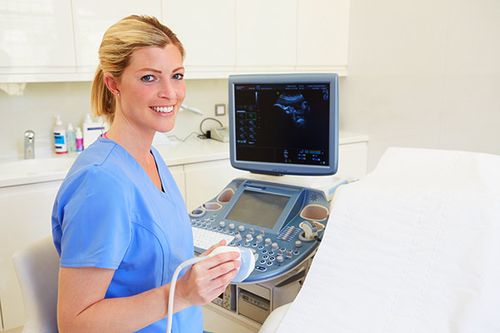
In summing up, I would like to say that thanks to modern medicine, the desire to become parents in the absence of a physiological possibility is quite feasible. You just need to try hard, have a great desire and always move forward!
Who said that curing infertility is difficult?
- Have you been wanting to conceive a child for a long time?
- Many methods have been tried, but nothing helps...
- In addition, for some reason the recommended medications are not effective in your case...
- And now you are ready to take advantage of any opportunity that will give you the long-awaited baby!
In vitro fertilization allows those couples who have problems conceiving naturally to experience motherhood. Unfortunately, not every IVF is successful and statistics show that many cases of such fertilization end in termination of pregnancy in the early stages or it does not happen at all.
Any couple after IVF wants to know in the first few days whether everything is okay with the embryo in the uterus and whether the long-awaited event has occurred. Internal sensations can be deceptive, so you can check your condition by measuring it during IVF. A table of the values of this hormone will not only tell you about the onset of pregnancy, but will also help you monitor it throughout the entire intrauterine period of the baby’s development.
What does this term mean?
Human (hCG) is a special hormone that begins to be produced by the villous membrane of the embryo (chorion) from the first days of conception. This process occurs almost immediately after the implantation of the embryo.
After a successful one, they indicate that the process of fetal development is proceeding successfully. A table of the values of this hormone allows both the doctor and the woman herself to monitor her condition and find out in time about possible complications: the threat of miscarriage, missed abortion, etc.
Important! prescribed to all women after the IVF procedure in order to recognize the onset of pregnancy and monitor the condition of the unborn child during it.
How to determine the level of this hormone
The growth of the hormone can be recorded by laboratory methods already 10-14 days after successful implantation of the embryo. Spouses can independently find out about pregnancy using a home test.
Test strips for home use are sold in every pharmacy. Their task is to detect an increase in hCG levels, which indicates pregnancy. A serious drawback is that they do not show the level of the hormone, but only indicate that it is higher than normal.
Women after IVF are recommended to take a blood test to find out their hCG levels. The data from such an analysis makes it possible not only to notice the growth of the hormone, but also to correlate its value with the norm for each period of gestation.
Table of hCG changes after IVF
In an ordinary healthy woman outside of pregnancy, the hCG level can reach up to 5 mU/l. Such values are considered acceptable and ordinary home tests will not catch them.
After the embryo has been implanted into the woman, if implantation is successful, hCG begins to grow after 4-7 days. At first it grows slowly, but after a few weeks a rapid increase in the levels of this hormone begins and every week this figure doubles.
By 11-12 weeks of intrauterine development, its values begin to increase at a less intense pace. Before the birth process, the amount of this substance in the body invariably increases.
The table below shows how this hormone increases during different weeks of gestation.

Exact numbers are not given too much importance, since the hCG number is not as important as how it grows over time. If the doctor has doubts, he recommends that the woman retake blood tests for this indicator several times in order to track the dynamics of hormone growth.
Important! Regular test strips cannot tell the expectant mother her hCG level. If you have any doubts or problems, you should immediately do a blood test and go to the doctor.
Table of hCG values by day after IVF
Unlike natural conception, with IVF the woman’s body is prepared for the upcoming implantation of the embryo with the help of hormonal drugs. Fertilization and intrauterine development of a child is a more complex process than just the effects of hormones, which may be why some IVF procedures end in failure.
After implantation of the embryo into the uterine cavity, the woman is recommended to check the hCG level every 2-3 days. This is necessary in order to monitor the development of pregnancy in the early, most dangerous stages of development and, if necessary, support its development with the help of additional medications.
The table below shows how hCG increases by day.
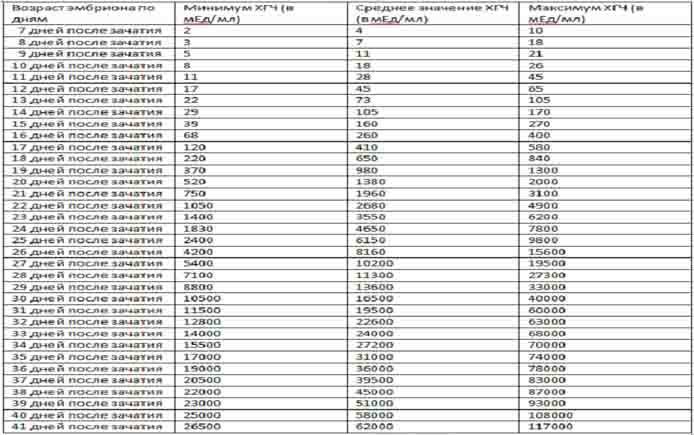
Important! The actual indicators of an individual woman may not coincide with the hormone norms, but, nevertheless, the pregnancy develops normally. The table is a guideline that experts rely on when assessing the baby’s intrauterine development.
How does hCG change during multiple pregnancy?
Standard practice with IVF is to implant 2-3 embryos at once in order to increase the chances of at least one of them developing. Many women begin to develop several implanted embryos at once, and specialists diagnose a multiple pregnancy. Twins are more common than others.
In such situations the body expectant mother hCG begins to be synthesized, which is produced simultaneously by two membranes of the embryo. In these cases, its level is approximately two times higher than at the same period during a singleton pregnancy.
The table below illustrates hormone levels in twins.
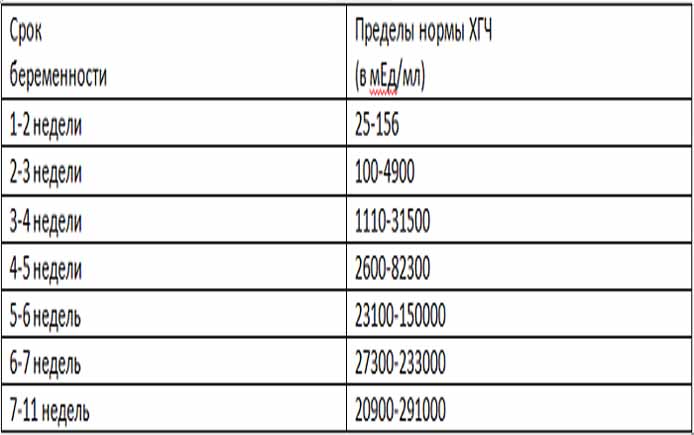
When deviations from the norm occur
When taking a hormone test after IVF, you need to understand that real numbers may differ from the table values. And this does not mean at all that you have problems. For all questions, it is better to consult with the doctor who is managing the pregnancy.
A decrease in hCG levels may be normal or may signal the onset of a miscarriage or missed pregnancy. High levels of the hormone occur during multiple pregnancies, toxicosis, diabetes mellitus and other conditions.
Carrying out IVF is always associated with the risk of miscarriage, termination of pregnancy and other complications. Measuring the level of human chorionic gonadotropin allows you to monitor the dynamics of fetal development and promptly notice the development of pathology in order to avoid complications and preserve the life and health of the mother. If you have doubts or questions, you should always call a doctor for help, who will tell you what to do in a particular situation.
After embryo transfer during in vitro fertilization (subject to successful fertilization), the patient’s blood begins to produce the hCG hormone. This is one of the main indicators for determining pregnancy in the early stages. But to determine its level, the hormone content must reach the required minimum level. That's why level analysis human chorionic gonadotropin only 14 days after the IVF procedure. At this point, the level of the hormone will either reach the level characteristic of pregnancy or will be absent in the blood.
The hCG level is measured in special units of honey per 1 ml of the patient’s blood. If at the time of blood collection on day 14 the value is below 5 mU/ml, then this indicates that the embryo transfer was unsuccessful. With a value of 25 mU/ml and above, as written in the table below, we can safely speak of a normal pregnancy.
One, after receiving positive results from measuring the level of the pregnancy hormone, doctors still recommend undergoing an ultrasound to confirm pregnancy. In addition, this first ultrasound during pregnancy allows us to assess the initial development of the fetus. An ultrasound can determine an ectopic pregnancy (it also produces hCG) or the number of fertilized eggs (what if you have two children at once, or even more).
Growth rates of the hCG hormone after transfer.
There is a table of hCG levels after embryo transfer into the uterus, which is widely used in obstetric practice. The values in it are as close as possible to the level of the hormone during normal pregnancy. This sign is used not only by doctors, but also by patients of IVF clinics to decipher test results.
In most pregnant women, levels increase within 2-3 days. human chorionic gonadotropin approximately twofold. But it is worth considering the individuality of each organism. If you are not experiencing such rapid growth, or, on the contrary, it is not so active, this does not mean that something is wrong with the course of pregnancy.
4-5 weeks after embryo transfer, hCG growth slows down. And after 10 weeks, the level of this hormone in the blood generally begins to decrease. These values are not included in the hCG table, but you can take our word for it.




